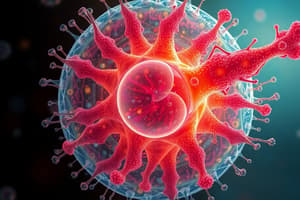Podcast
Questions and Answers
What is the Endosymbiotic Theory?
What is the Endosymbiotic Theory?
The theory states that eukaryotic cells evolved from the symbiotic relationship between two or more prokaryotic cells.
What evidence supports the Endosymbiotic Theory?
What evidence supports the Endosymbiotic Theory?
- Chloroplasts and mitochondria (correct)
- RNA sequences
- Fossil records
- Animal cell structures
Eukaryotes have fewer genes than prokaryotes.
Eukaryotes have fewer genes than prokaryotes.
False (B)
Which of the following structures reproduce by binary fission?
Which of the following structures reproduce by binary fission?
How did the first multicellular organisms likely arise?
How did the first multicellular organisms likely arise?
What are some similarities between chloroplasts, mitochondria, and prokaryotes?
What are some similarities between chloroplasts, mitochondria, and prokaryotes?
Which of the following statements about eukaryotic evolution is true?
Which of the following statements about eukaryotic evolution is true?
Flashcards are hidden until you start studying
Study Notes
Eukaryotic Evolution and Diversity
- Eukaryotes emerged around 2 billion years ago, significantly contributing to Earth's biodiversity.
- They possess a greater complexity compared to prokaryotes, characterized by a larger genome supporting diverse forms and functions.
Endosymbiotic Theory
- Proposes that eukaryotic cells evolved from a symbiotic relationship between multiple prokaryotic cells.
- One prokaryotic cell engulfed another simpler cell, which survived and became integrated within the host.
- Many organelles in eukaryotes are considered remnants of once-independent prokaryotes.
Evidence of Endosymbiosis
- Chloroplasts and mitochondria are strong evidence for the Endosymbiotic Theory.
- Both organelles retain features similar to prokaryotes:
- They have comparable membranes and ribosomes.
- Both reproduce independently through binary fission.
- Each contains circular DNA resembling bacterial genomes.
- Genetic sequences between these organelles and certain prokaryotes show significant matches.
Origin of Multicellularity
- The first multicellular organisms likely originated from colonies formed by cell division of individual prokaryotes.
- The genetic makeup of these cells included instructions for specialization, allowing for the evolution of complex multicellular organisms.
Homework Assignments
- Read pages 61 to 62 for further insights on eukaryotes.
- Complete exercises on page 71, focusing on questions 1, 4, and 8.
- Watch provided video links for additional learning on the subject matter.
Studying That Suits You
Use AI to generate personalized quizzes and flashcards to suit your learning preferences.




